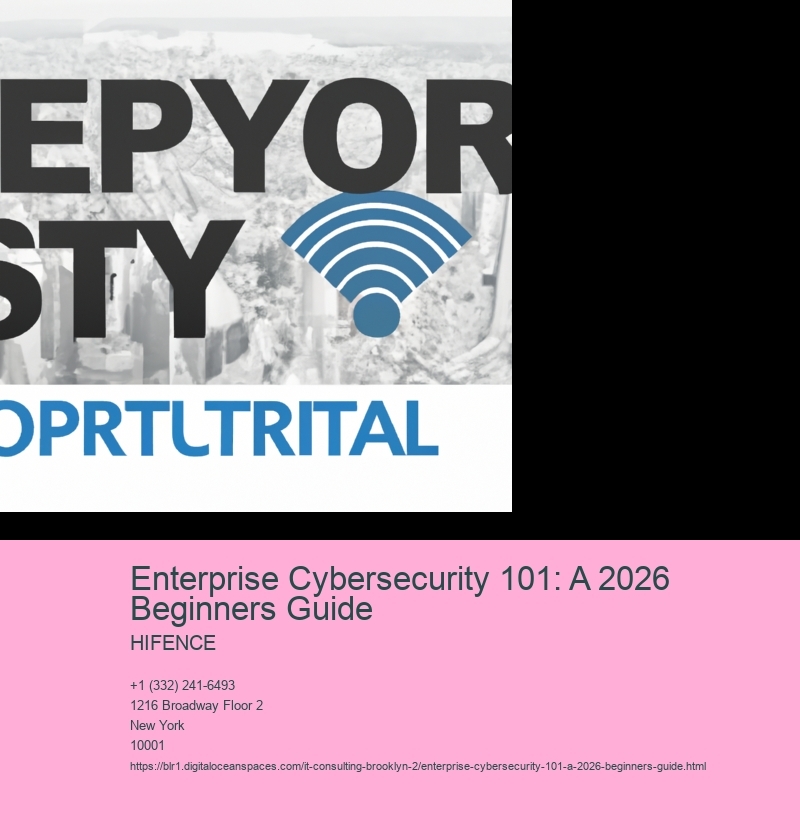Enterprise Cybersecurity 101: A 2026 Beginners Guide
managed it security services provider
Understanding the Evolving Threat Landscape (2026 Edition)
Okay, so like, Enterprise Cybersecurity 101 in 2026? Cybersecurity for Large Enterprises: Strategies for SMBs . Sheesh, thats like trying to predict the weather in five years, but for bad guys online. Understanding the Evolving Threat Landscape (2026 Edition) is gonna be, um, crucial, for anyone just starting out.
Think about it. 2026 aint gonna be your grandmas internet. AI is gonna be way smarter, quantum computing might be, like, a real thing for hackers, and the Internet of Things? Forget about it. Every coffee maker and toaster a potential back door!
The threats were gonna face? Its not just viruses anymore. Its sophisticated ransomware attacks holding entire companies hostage! AI-powered phishing emails that are, like, impossible to tell from the real thing. And nation-state actors trying to steal secrets and mess with critical infrastructure. Its a lot!
For beginners, understanding the basics is still key. Like, what is a firewall, how to spot a dodgy email, and why you REALLY need strong passwords. But also, theyll need to be clued in on things like zero-trust architecture and the importance of continuous monitoring.
Enterprise Cybersecurity 101: A 2026 Beginners Guide - managed it security services provider
Key Cybersecurity Frameworks and Compliance Standards
Okay, so, like, youre just starting out in enterprise cybersecurity, right? check Its 2026, and things are moving FAST. One thing you gotta wrap your head around are these "Key Cybersecurity Frameworks and Compliance Standards." Sounds super boring, I know!, but trust me, they are important.
Think of frameworks like a recipe book for security. Like, NIST CSF (National Institute of Standards and Technology Cybersecurity Framework) is a big one. It gives you a structure for identifying risks, protecting your assets, detecting threats, responding to incidents, and, like, recovering from stuff going wrong. Sorta a general guide, really. Then theres ISO 27001, which is more internationally focused, and focuses on information security management. Its more about seting up processes.
Compliance standards are different. These are laws or rules that you have to follow, depending on your industry and where you do business. Think HIPAA for healthcare, protecting patient data. Or GDPR if you are dealing with Europeans, its all about that privacy, you know. PCI DSS if you are taking credit card payments. Compliance is less "suggestions" and more "do this or get fined." They can be a real pain, but good security usually helps with compliance anyway.

The tricky part is, like, figuring out which frameworks and standards apply to you. It depends what your company does, what data you handle, and where you do business. So learn up! Its a lot, but it will keep your company safe and out of big trouble.
Essential Security Technologies for Modern Enterprises
Enterprise Cybersecurity 101: A 2026 Beginners Guide - Essential Security Technologies for Modern Enterprises
Okay, so you wanna get into enterprise cybersecurity, huh? Welcome! Its gonna be wild, especially by 2026. managed it security services provider Forget what you think you know, because things are gonna be, like, super different. We aint just talking about firewalls anymore.
Lets talk essential technologies, stuff you need to know about. First, Identity and Access Management (IAM). This is HUGE. Think of it like the bouncer at a club, but for your entire company network. Who gets in, what can they do? IAM makes sure only the right people are accessing the right stuff. Get this wrong, and its game over, man.
Next up, Endpoint Detection and Response (EDR). Every computer, every phone, every thing connected to your network is an endpoint. EDR is like having a security guard watching each one for shady activity. Its gotta be smart, too, using AI to spot threats that look new and unusual. Its amazing!
Then theres Security Information and Event Management (SIEM).
Enterprise Cybersecurity 101: A 2026 Beginners Guide - check
- check
- managed it security services provider
- check
- managed it security services provider
- check
- managed it security services provider
- check
Cloud Security is also super important. Most companies are using the cloud, and you need tools to secure that environment. Cloud access security brokers (CASBs) are key here, acting as a gatekeeper between your users and cloud applications.

Finally, dont forget about Vulnerability Management. Regularly scanning your systems for weaknesses is crucial. You gotta patch those holes before the bad guys find them. And that means keeping up-to-date on everything, which is a full-time job in itself.
Learning all this takes time and effort, so dont get discouraged. But if youre serious about enterprise cybersecurity in 2026, these technologies are where you gotta start. Good luck, future cyber warrior!
Building a Robust Cybersecurity Team and Culture
Okay, so like, building a killer cybersecurity team and a good culture is, like, super important for any business, especially by 2026! Think about it: everyones online, everythings connected, and theres gonna be even more hackers trying to steal your data or, worse, hold you hostage.
You cant just hire a bunch of super-smart tech whizzes and expect them to magically fix everything, though. You need a team that works together, that trusts each other, and that, you know, actually likes being there. Thats where the culture part comes in.
A good culture means open communication. People should feel comfortable reporting problems, even if they made a mistake! No blaming, just fixing. It also means constantly learning. Cybersecurity is always changing, so your team needs to be up-to-date on the latest threats and technologies. Think regular training, conferences, maybe even letting them play around with some ethical hacking tools!
And dont forget about diversity! Different backgrounds and perspectives can help you spot vulnerabilities you might otherwise miss. A team of all the same type of people, its not gonna do much!

Ultimately, building that robust team and culture is an investment. It costs money, it takes time, but its way cheaper than dealing with a major data breach, believe me! Plus, a happy and well-trained cybersecurity team is just, like, a huge asset to any company. Do it right, and youll be way better protected than most!
Incident Response Planning and Disaster Recovery
Okay, so you are just starting out in enterprise cybersecurity, huh? Welcome to the club! One thing youre gonna hear a lot about is Incident Response Planning and Disaster Recovery. Basically, its all about what happens when things go wrong, and trust me, things will go wrong!
Incident Response Planning is like, your playbook for when a hacker gets in, or some malware starts running wild. Its not just about yelling "Oh no!", its having a step-by-step thing to follow. Who do you call? What systems do you shut down? How do you figure out what happened? You need a plan, and you need to practice it, or else everythings gonna be chaos.
Disaster Recovery, on the other hand, is bigger picture. Think earthquake, fire, or even just a major, major power outage. Its about getting the whole business back on its feet. Where are your backups stored? How long can you be down before you starts really losing money? Can you run critical operations from a secondary site? Its all about business continuity.
These two things are connected, of course. A well-handled incident might prevent a full-blown disaster! But they are also different. One is like fixing a leaky faucet, the other is like rebuilding after a flood.
Dont think you can just write these plans once and forget about them either. Technology changes, threats evolve, and your business changes! You gotta review and update them regularly, like, at least once a year. Its a lot of work, I know it. But its way, way less work than dealing with a major security breach or a complete system failure without any plan in place. Believe me, you dont want to be that person! Good luck gettin started!
Cybersecurity Budgeting and ROI for Beginners
Cybersecurity Budgeting and ROI for Beginners: A 2026 Look
Okay, so youre diving into enterprise cybersecurity, and its 2026? Cool! One of the first hurdles youll face, and its a big one, is figuring out the budget. Its not just about throwing money at shiny new firewalls (though those are important!). Its about smart spending.
Think of your cybersecurity budget like this: its an investment. Youre investing in protecting your companys assets, reputation, and maybe even your job! But how do you justify that investment to the higher ups? Thats where ROI (Return on Investment) comes in.
ROI, basically, is how much bang you get for your buck. You need to show that spending X amount on cybersecurity will prevent Y amount of losses. This can be tricky, cuz you are tryin to prevent something from happening! How do you measure something that didnt happen?
Well, start by identifying your biggest risks. What are the most likely threats to your business? Ransomware? Data breaches? Phishing attacks? Once you know your risks, you can research solutions. Then, estimate the potential cost of each risk if it were to materialize. A data breach could cost millions in fines, legal fees, and damage to your reputation.
Now, look at the cost of the cybersecurity solution. A good antivirus software, employee training, regular security audits, all cost money. Compare the cost of the solution to the potential cost of the risk. If the solution costs $10,000 but could prevent a $1 million data breach, thats a pretty good ROI!
Dont forget to factor in indirect benefits. Stronger cybersecurity can improve customer trust, attract investors, and even boost employee morale. These things are harder to quantify but are definitely worth considering. Remember, its not a perfect science, but presenting a well-reasoned argument with clear numbers and a focus on risk mitigation is key. Good luck!
The Future of Enterprise Cybersecurity: Trends to Watch
Okay, so you wanna get into enterprise cybersecurity, huh? Good choice! By 2026, things are gonna be wild. Like, imagine everything you know now, but cranked up to eleven. This aint your grandpas antivirus software anymore.
First off, AI is HUGE. Like, ridiculously huge. Were talking AI that doesnt just detect threats, it predicts them. Think Minority Report, but with firewalls. But, of course, the bad guys are gonna be using AI too, so its like, an AI arms race which is pretty scary!
Then theres zero trust. Forget the whole "trust everyone inside the network" thing. By 26 its gonna be "trust no one, ever, not even your own grandma." Every device, every user, every application has gotta prove itself constantly. Its a pain, but its also necessary.
Cloud security? Still a big deal, but even more complicated. Everythings gonna be in the cloud, or some weird hybrid version thing, so protecting all that data is gonna be a massive headache. Gotta learn all about container security, serverless architecture, and all that jazz.
And dont even get me started on quantum computing. Once those things become a reality, like, all our encryption is basically toast. Gotta start preparing for post-quantum cryptography now. Its a lot to take in!
Oh, and one more thing: humans. Yeah, theyre still the weakest link. Social engineering is gonna get even more sophisticated, so training employees to spot phishing scams and other tricks is gonna be even more important.
So yeah, its a lot. But if youre willing to learn and adapt, enterprise cybersecurity in 2026 is gonna be a pretty exciting place to be!
